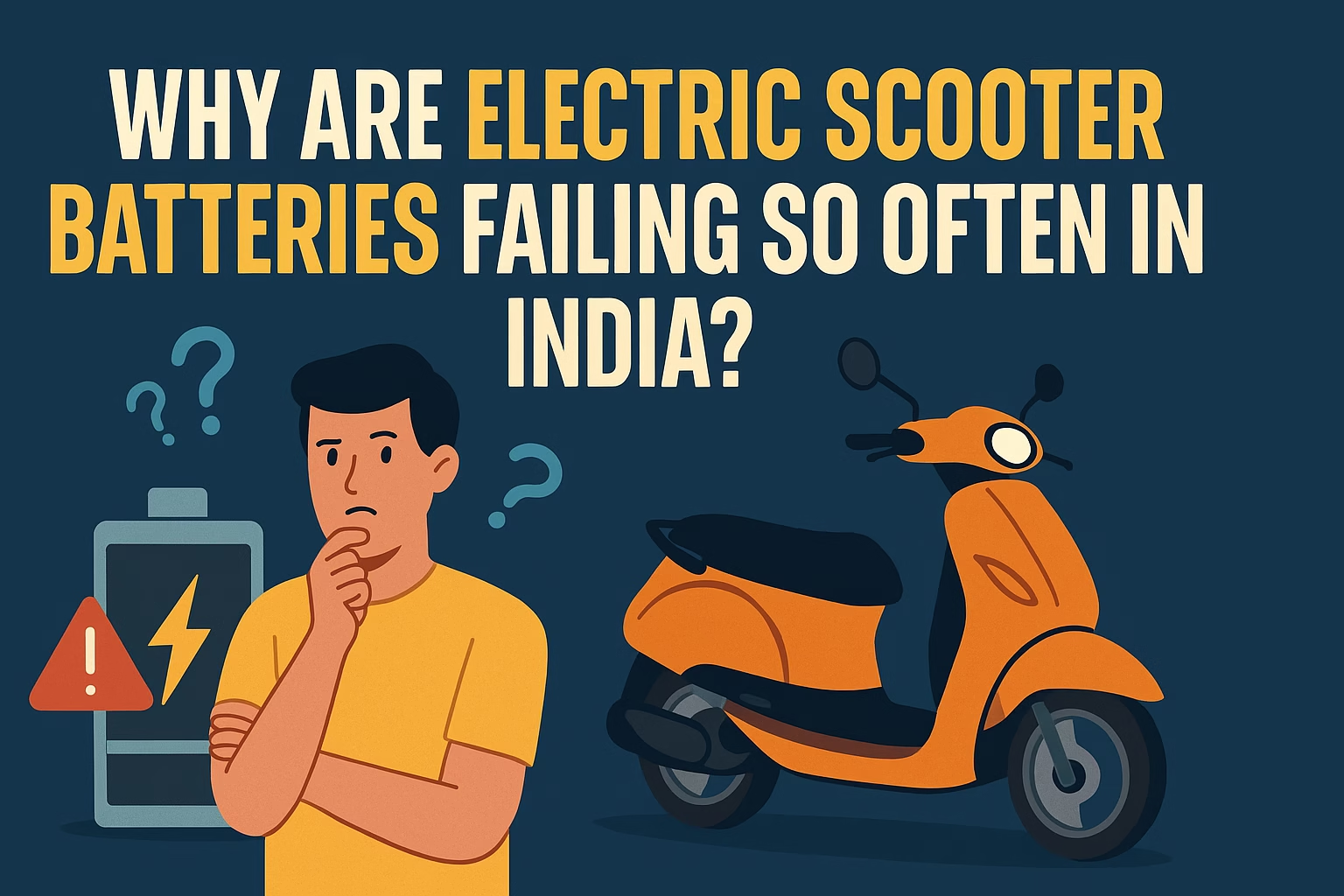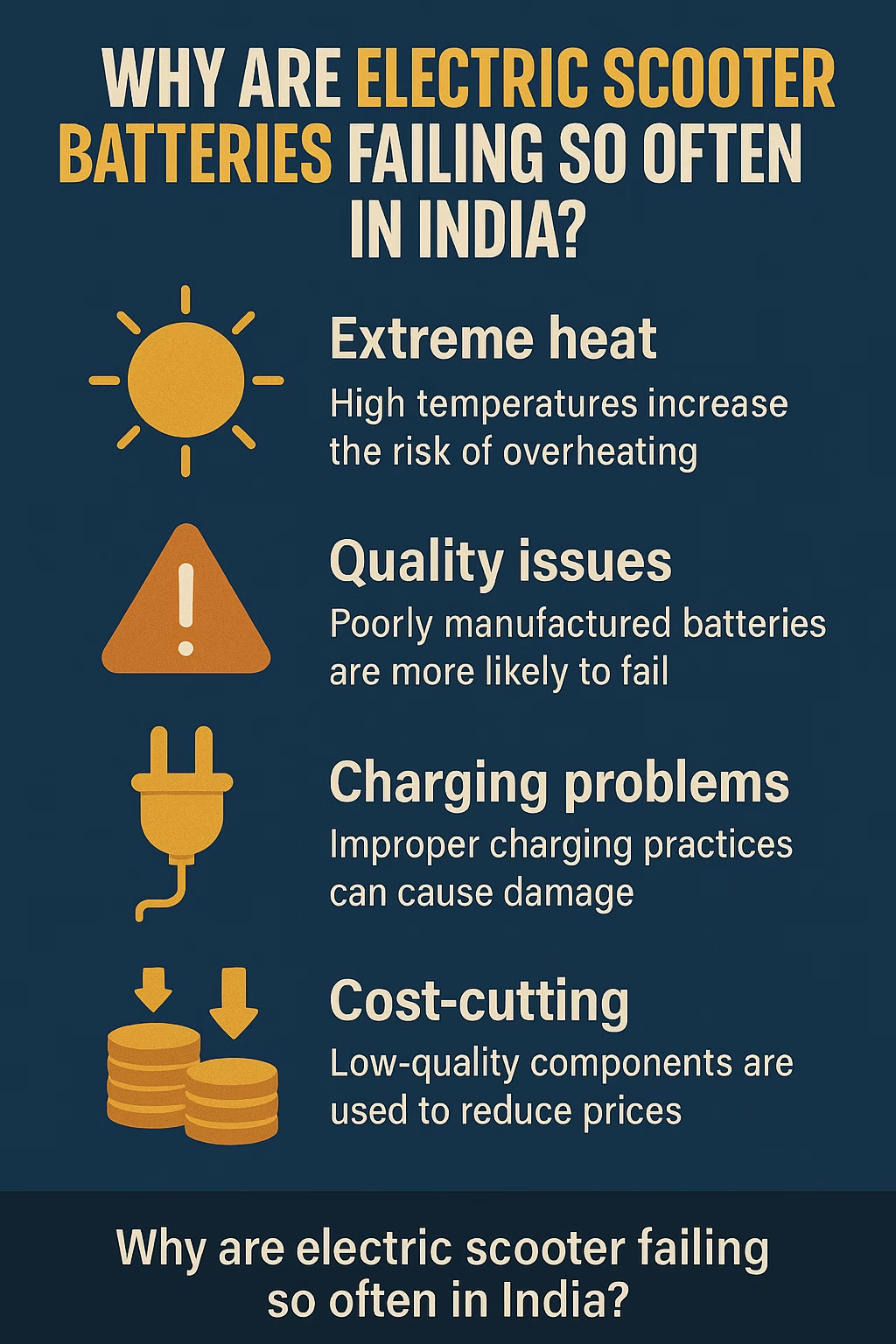Introduction
Electric scooters have taken India by storm. From metro cities to tier-2 towns, e-scooters are quickly becoming the go-to commute option for the eco-conscious, cost-savvy rider. But with the rise of EV adoption, another trend is silently gaining traction: electric scooter battery failure in India.

Social media is full of users reporting battery issues just months after purchase. From sudden battery drops and overheating to complete shutdowns, Indian riders are facing serious reliability concerns. But why is this happening? And more importantly, how can you avoid becoming the next victim?
Let’s decode the electric scooter battery failure in India crisis—with real causes, solutions, and tips no one is telling you.
What Counts as electric scooter battery failure?
Battery failure doesn’t always mean the scooter won’t start. Here are the most common signs of electric scooter battery failure in India:
- Sudden drop in charge from 100% to 30%
- Scooter not holding charge overnight
- Overheating while charging or riding
- Unusual noises or burning smell
- Charging time increasing day by day
- Battery percentage stuck or showing false readings
Upcoming Electric scooters under 1 lakh India 2025
The Real Reasons Behind Battery Failures in India
1. Extreme Climate Conditions
Indian summers often cross 45°C and winters drop below 5°C in some regions. Most lithium-ion batteries used in e-scooters are not optimized for such temperature fluctuations. This leads to:
- Thermal runaway in high heat
- Reduced charge cycles in cold
- Swollen battery cells
Electric scooter battery failure in India is often due to lack of thermal management.
2. Low-Quality Battery Cells
Several EV brands (especially startups) use cheap or untested Chinese cells to cut costs. These may not meet BIS (Bureau of Indian Standards) safety norms, leading to early degradation.
3. Improper Charging Practices
Charging overnight, using local extension cords, or charging immediately after a ride (while the battery is still hot) shortens battery life. Sadly, most users are unaware of this.
4. Poor Battery Management Systems (BMS)
A good BMS prevents overcharging, overheating, and over-discharging. But many scooters in India have weak or outdated BMS software, which fails to protect the battery.
5. Dust, Water, and Vibration Exposure
India’s roads are rough, dusty, and often flooded. If the battery enclosure is not IP67 rated (dust and water proof), particles seep in and corrode the battery terminals over time.
6. Fast-Charging Abuse
Many riders prefer fast-charging for convenience. But repeated fast charging stresses battery chemistry, causing early wear. For most users, this is a hidden cause of electric scooter battery failure in India.

Which Brands Are Facing the Most Complaints?
While every brand has some issues, users have reported recurring battery failures with:
- Ola S1 Pro (especially Gen 1 models)
- Hero Electric Photon & Optima
- Okinawa Praise Pro
- Bounce Infinity
- Ampere Magnus
That said, even premium scooters from Ather and Bajaj Chetak have faced isolated battery complaints.
How to Prevent Electric Scooter Battery Failure in India
✅ Charge Smartly
- Always use the company-supplied charger.
- Avoid charging right after a long ride.
- Don’t leave the scooter charging overnight.
- Maintain battery between 20% to 80% for longer life.
✅ Avoid Fast Charging Unless Necessary
Use it occasionally, not daily. Normal charging is gentler on the cells.
✅ Protect from Extreme Heat & Cold
- Park in shaded or covered areas.
- Avoid leaving the scooter under direct sun for long hours.
- Don’t ride during freezing early morning temperatures.
✅ Update the BMS Firmware
Some brands like Ather and Ola push regular software updates. Make sure your scooter’s firmware is up-to-date.
✅ Insist on a Warranty with Cell Details
Ask your dealer about the cell type used (LFP, NMC, etc.), the brand (LG, Panasonic, etc.), and battery warranty.
✅ Service Regularly
Get your battery terminals cleaned and enclosure checked for water or dust damage every 3 months.
Should You Buy an Extended Battery Warranty?
Yes—especially if you ride daily or commute long distances. Brands like Ather and Ola offer paid warranty extensions that cover battery degradation up to 5 years.
Considering how widespread electric scooter battery failure in India is becoming, this small investment can save you from massive repair bills.
Government’s Role in Battery Safety
In 2023, the Indian government introduced stricter battery safety norms under AIS-156. This mandates:
- Better thermal protection
- Quality testing of battery cells
- Clear warranty policies
- Fireproof casings
Brands failing to meet this can be fined or banned. Yet, enforcement remains weak in semi-urban and rural markets.
What to Do if Your Battery Fails?
- Check Warranty Coverage: Most batteries come with 3-year warranties.
- Visit Authorized Service Center: Don’t go to local mechanics. They void warranty.
- File a Complaint: Use the company’s helpline and get a complaint ID.
- Approach Consumer Forum: If the company fails to respond, legal options exist.
Real Stories from Indian Users
“My Ola S1 Pro battery dropped from 95% to 15% within a few kms. Turns out it was overheating inside the casing. Ola replaced it but only after weeks of calls.” — Ankit Sharma, Delhi
“I charged my Okinawa scooter using a power strip and the charger burned out. Lesson: always use a direct wall socket.” — Shruti Jain, Pune
Conclusion: Buy Smart, Ride Smart
Electric scooters are the future of Indian mobility. But we must recognize that electric scooter battery failure in India is a growing issue caused by climate, cost-cutting, and consumer habits.
With the right care and knowledge, you can prevent most battery issues and enjoy a smooth, sustainable ride.
Whether you’re a first-time buyer or current EV user, take the time to understand your battery—because it’s not just a part of your scooter. It is the heart of your ride.
